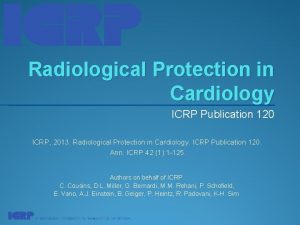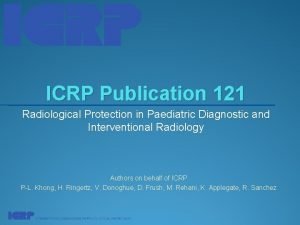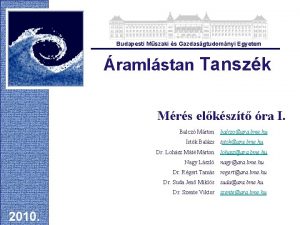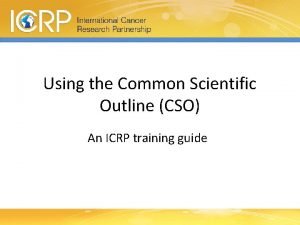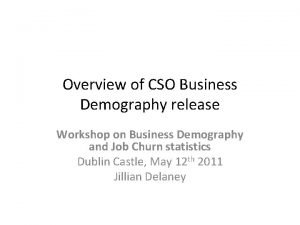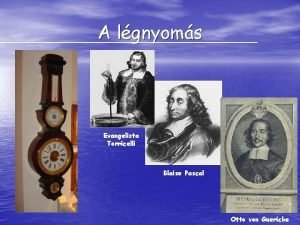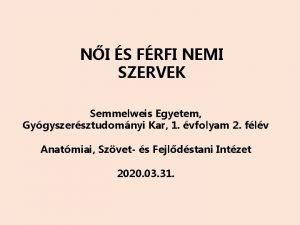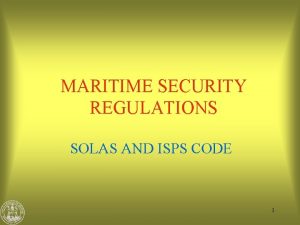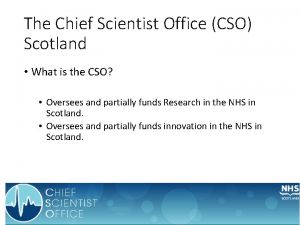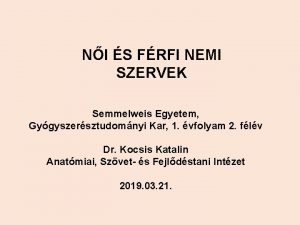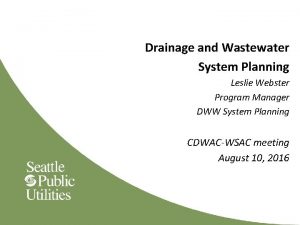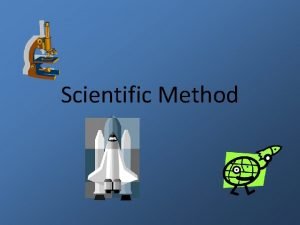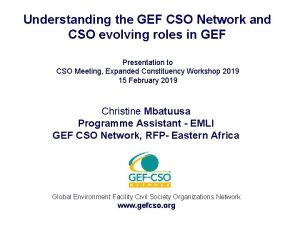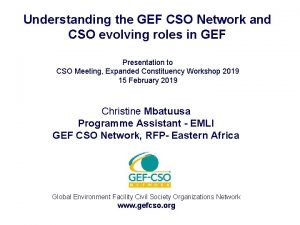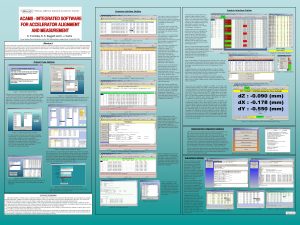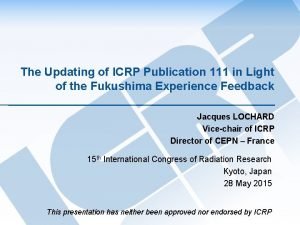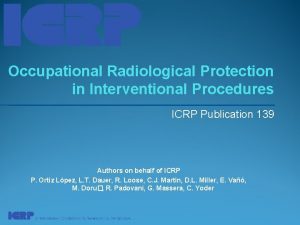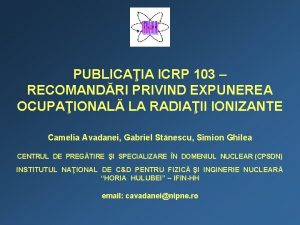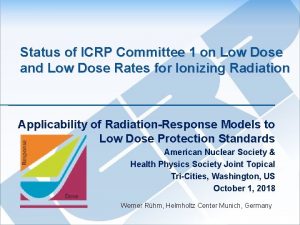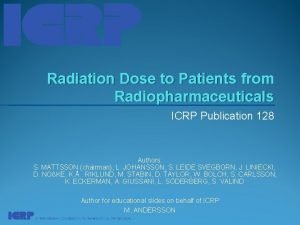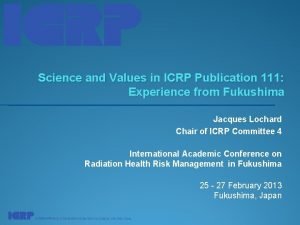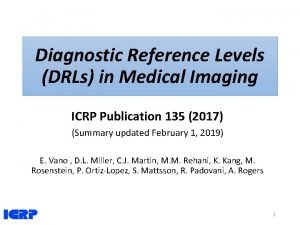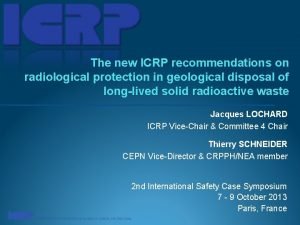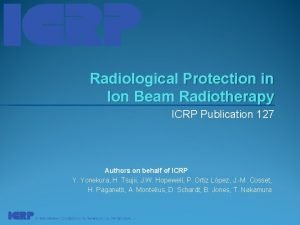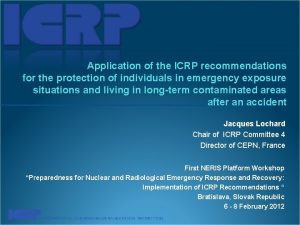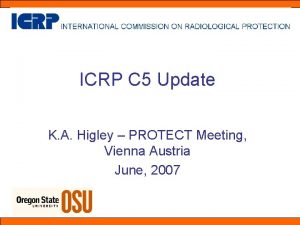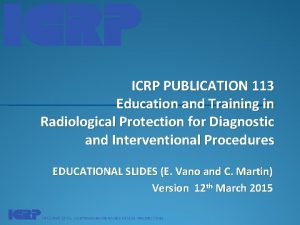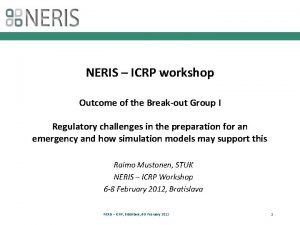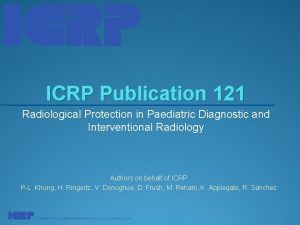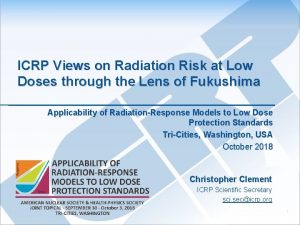Using the Common Scientific Outline CSO An ICRP


























- Slides: 26

Using the Common Scientific Outline (CSO) An ICRP training guide

Background – why use the CSO? • Organizations in the International Cancer Research Partnership, have agreed to apply a common language—the Common Scientific Outline (CSO)—for discussing, comparing, and presenting their cancer research portfolios. • The CSO, a classification system organized around seven broad areas of science, along with a standard cancer type coding scheme provides the tools needed to lay the groundwork for collective portfolio analyses and enable coordinated strategic planning among the partner organizations.

CSO – a springboard for planning & collaboration • Collective portfolio analysis will enable greater understanding of the international context • The ICRP network provides a mechanism to address gaps and opportunities in a coordinated way

The basics of coding What information do I need about the research proposal? • You need the project title, and a research abstract (we suggest a 100 words as a minimum). You don’t need the full text of the research proposal , but it can be helpful to have access to it to resolve questions.

The basics CSO coding • Try to describe only the MAIN aims of the award, not every research idea. Sometimes, it is helpful to check the project title to help you focus on the main aim. It can also be helpful to think back from the CSO (e. g. “If I was doing an analysis of CSO 3. 3 “Chemoprevention”, would I want to find this abstract? ”) Type of cancer • By contrast, for Cancer Type (Disease site) you want to capture ALL of the relevant disease codes. • Code to the primary tumour (not the metastatic site) Type of award • Is it a clinical trial? If yes, put “C”. If not, is it a training award? If yes, put “T”. For any other awards put “R” (Research).

The basics • In the next few slides, we will take you through some examples of science extracted from research abstracts to give you an insight into the principles of coding. You can then follow up using your practice pack to test yourself against some coded research on the ICRP database. • It can be very helpful to discuss coding problems with colleagues/other ICRP Partners/Operations manager. This can help to focus down on the real aims of the research.

Example 1: CSO 1 - Biology Research included in this category looks at the biology of how cancer starts and progresses as well as normal biology relevant to these processes. Proteomic Approach to Identify Regulators of Stem Cell Self-Renewal • “…. . Although the molecular network controlling stem cell self-renewal remains poorly defined, a number of key genes have been identified that either regulate or profoundly modulate this process…. . we will investigate potential key signalling molecules and the downstream target proteins that participate in stem cell self renewal. ” Area Coding Notes CSO 1. 1 This is about the normal biology of the system Disease site Not site-specific It is not relevant to any particular cancer type Award type R It is not a clinical trial, or a training award

Example 2: CSO 2 – Aetiology/Causes Research into the causes or origins of cancer – genetic, environmental and lifestyle, and the interactions between these factors Allergies, Genetic Susceptibility and Adult Glioma Risk “…. . In the course of this MSc training project, the student will examine Ig. E levels in blood specimens, SNPs of genes strongly related to allergies or asthma (IL-4, IL-4 Ralpha, IL-13, Fce. RI-p, IL-10, CTLA- 4), and known functional variants of two detoxification genes (GSTP 1 and GSTT 1) in relation to the risk of gliomas. ” Area Coding Notes CSO 2. 3 Looking at interaction of external factors – allergenic agents, with genetic background (detoxification genes) Disease site Brain Award type T It’s an MSc project

Common problems: CSO 2 - Aetiology CSO 2 or CSO 1? • Research to establish if a gene, protein or external factor is involved in cancer causation is coded to CSO 2. Investigation of the biology of factors known to be involved in cancer aetiology is coded to CSO 1. Cancer Stem Cells • Coding depends on the purpose of the research – cancer causation is in CSO 2, biology is in CSO 1. New in CSOv 2: phrasing revised to underline this.

Example 3: CSO 3 - Prevention Identifying/researching interventions which reduce cancer risk by reducing exposure to cancer risks and increasing protective factors. Interventions may target lifestyle or may involve drugs or vaccines Aspirin And Colorectal Cancer Prevention “…. . This application proposes to conduct a randomized doubleblind clinical trial which will assess the ability of aspirin to reduce colorectal cancer risk in a US cohort. This project will randomize . . . ” Area Coding Notes CSO 3. 3 Studies on the effect(s) of chemicals/drugs on cancer prevention Disease site Colorectal Award type C A clinical trial

Common problems: CSO 3 - Prevention CSO 3. 1 – Behavioural interventions • Educational interventions can be coded here (e. g. , delivering a smoking prevention programme to children). New in CSOv 2 CSO 3. 2 – Nutrition • All preventive nutritional research is coded here. New in CSOv 2 CSO 3. 4 – Vaccines • Only for preventive vaccines (e. g. , HPV vaccines) • Therapeutic vaccines are coded to CSO 5

Example 4: CSO 4 – Early diagnosis/prognosis Identifying & testing cancer markers and imaging methods that are helpful in detecting and/or diagnosing cancer as well as predicting the outcome or chance of recurrence. Early diagnosis of pancreatic cancer “…. . The goal of this project is to develop early diagnostic tests for pancreatic cancer. . experimental approach is to identify novel proteins that are expressed in the sera and body fluids of patients with premalignant lesions of the pancreas (pancreatic intraepithelial neoplasms - Pan. In) by using proteomics techniques. We will employ different highly sensitive and complementary proteomics approaches to identify novel proteins and peptides that appear in serum. . ” Area Coding Notes CSO 4. 1 Discovery of new biomarkers for diagnosis Disease site Pancreatic Award type R It is not a clinical trial, or a training award, but a research study on patient samples

Common problems: CSO 4. 1, 4. 2 or 4. 3 – where’s the boundary? • Generally discovery projects to find new biomarkers (for example) go in 4. 1. Validation in a pre-clinical setting is in 4. 2, clinical testing is in CSO 4. 3. CSO 4 – is it just for biomarkers? • No, any method or tool for detection, diagnosis or prognosis can be coded to CSO 4 (e. g. , imaging studies to detect tumours).

Example 5: CSO 5 – Treatment Identifying & testing treatments administered locally or systemically as well as complementary treatments. Prevention of recurrence is also included. Development of Multi-Probe Radiofrequency Ablation “…. . Radiofrequency (RF) ablation is a widely accepted method to focally destroy cancers of the liver, and GI tract. . In this proposal, we will create a multiple-electrode prototype system for use with an experimental high power RF generator, to optimize the system, and characterize the system in vivo in model systems. ” Area Coding Notes CSO 5. 1 Developing a new methodology for a localised treatment, not yet in clinical testing so 5. 1 not 5. 2 Disease site Gastrointestinal, liver Award type R or C Depends on whether tested in patients…

Common problems: CSO 5 Where do combination therapies go? • Clinical testing of combinations of 2+ systemic therapies are in CSO 5. 4 • Clinical testing of combinations of 2+ localised therapies are in CSO 5. 2 • Novel combinations of localised and systemic therapies are in CSO 5. 5 (e. g. , combining new radiotherapy regime with one or more systemic therapies)

Example 6: CSO 6 – Cancer control, survival Includes patient care and pain management; tracking cancer cases in the population; beliefs and attitudes that affect behaviour regarding cancer control; ethics, education and communication approaches for patients and health care professionals; supportive and end-of-life care; and health care delivery in terms of quality and cost effectiveness. Access to care at the end of life: Encounters between home care nurses and family caregivers “…. . The purpose of this study is to gain a better understanding of the factors that home care nurses take into account when making decisions about the need for and amount of home care nursing services at the end of life. ” Area Coding Notes CSO 6. 6 End of life care Disease site Not site-specific Relevant to all cancers Award type R It is not a clinical trial, or a training award

Some changes to the CSO When ICRP issues new data reports, inter-coder variation studies are done as part of the process. This can highlight areas of ambiguity/confusion. The ICRP Coding group recently reviewed some of these areas and is now working to CSOv 2 (which we will use today). The main changes are: • CSO 7 category (model systems) is retired. Model systems are coded to the relevant Resources & Infrastructure areas of CSO 1 -6 • CSO 6 category: behavioural interventions for prevention now coded to CSO 3 exclusively • CSO 3 category: all nutritional interventions grouped to CSO 3. 2 • There are some other minor changes, but these are mainly extra bullet points for clarification, or to assist coders The main aims of these changes are to improve usability, reduce ambiguity in codes and make data analysis easier.

CSO v 1 -v 2 changes: CSO 7 Historical code Example 1: Model systems are now coded to the relevant Resources & Infrastructure areas of CSO 16“…. . The objective of this proposal is to finish validation of a unique transgenic mouse model for applications in preclinical toxicology…. The K 6/ODC mouse overexpresses the enzyme ornithine decarboxylase in skin and internal organs and is exquisitely sensitive to topically applied carcinogens. The specific aims of the application are to determine the tumor response of K 6/ODC mice to systemically administered chemicals…. Use of this model will reduce the time, cost, and number of animals required for regulatory purposes as compared to existing models. . ” Area Old codes New v 2 codes CSO 7. 1 5. 7 (a tool to assist in drug discovery)

CSO v 1 -v 2 changes: CSO 7 Historical code Example 2: Model systems are now coded to the relevant Resources & Infrastructure areas of CSO 16“…. . We have shown that murine models carrying a Denys-Drash syndrome (DDS) mutation display the characteristic symptoms of DDS including the only Wilms'' tumour ever to have formed in a W 1 mutant - associated with a second hit disrupting the wild type transcript. Furthermore, we have recently observed nephrogenic rests (persistent metanephric blastema considered to be a precursor to Wilms' tumour) in grossly normal kidneys taken from 6 -8 week DDS models…. . Our DDS system provides an excellent resource for studying stages of progression of Wilms' tumour. …. this project will increase our understanding of W 1 biology…. ” Area Old codes New v 2 codes CSO 7. 1 1. 5 (a tool to assist in understanding biology of tumour initiation/progression)

CSO v 1 -v 2 changes: CSO 7 Historical code Example 3: Use of model systems is now simply coded to the relevant research areas of CSO 1 -6 “…. . The ability to diagnose and treat disease has been greatly enhanced by the study of embryonic development in model organisms such as fruit flies, mice, and fish. When incorrectly regulated, many genes required for proper development of the embryo result in tumor formation. Of particular interest to cancer researchers are those developmental processes that require precise control of cell signaling and cell migration. Abnormal regulation of these processes is common in most types of cancer, leading …We are using tail formation in the zebrafish as a model system to understand the mechanisms that underlie particular aspects of cancer development. Specifically, we are studying a mutation that results in embryos with severely truncated tails. Our initial characterization of the mutated gene suggests that it may be required for intercellular signaling and cell migration. . . …. ” Area Old codes New v 2 codes CSO 1. 3, 1. 4 and 7. 2 1. 3 and 1. 4 (understanding biology of tumour initiation/migration: developing a model isn’t the main goal of the proposal)

CSO v 1 -v 2 changes: CSO 6. 8 Historical code Example: now coded to CSO 6. 1 “Exercise in a Stage IV Bca Sample: A Feasibility Pilot …. . The goal of this pilot project is to establish feasibility and generate initial outcome data concerning the physiological and affective benefits of a group exercise training program for women with recently diagnosed metastatic breast cancer. Building upon our successful exercise program which studies the effects of exercise on women with primary breast cancer, this project will determine whether a group exercise program can be an efficacious adjunctive intervention strategy for improving the health and quality of life of metastatic breast cancer patients. Women with metastatic breast cancer who provide informed consent will participate in a course of exercise training delivered in a structured group setting three times per week for 16 weeks. . ” Area Old codes New v 2 codes CSO 6. 1 and 6. 8 6. 1

CSO v 1 -v 2 changes: CSO 6. 3 Example: behavioral aspects of prevention now coded to CSO 3 “Exercise Intervention in Colorectal Polyp Patients “…. Strong observational evidence points to a link between physical activity and reduction in risk of colon cancer. The mechanisms for this association have not been delineated, nor have the amounts and types of exercise needed for a putative protective effect been determined. We propose a randomized controlled clinical trial of a one-year moderate aerobic/strength training exercise intervention in adenomatous colon polyp patients (n=100 men, 100 women). . . ” Area Old codes New v 2 codes CSO 3. 1 and 6. 3 CSO 3. 1 (behavioural intervention to prevent cancer)

CSO v 1 -v 2 changes: CSO 3. 1/3. 2 Example: Nutritional aspects of prevention now coded to CSO 3. 2 “Worksite Program to Increase Fruit and Vegetable Intake …. . exam The long-term goal of this project is to develop an effective community- based intervention, using worksites as communities, to increase fruit and vegetable consumption. It builds on the current Seattle 5 a Day project and aims to: 1) Use qualitative methods to modify the community- based 5 a Day intervention for increasing fruit and vegetable consumption to be appropriate for a worker with low socioeconomic status (SES); 2) Develop and automate an additional component, to augment the community-based 5 a Day intervention, which will produce individually tailored information and personalized feedback for low SES workers, 3) Evaluate the effectiveness of this intervention in increasing fruit and vegetable consumption using a rigorous randomized controlled trial of small worksites that employ low SES workers. . . ” Area Old codes New v 2 codes CSO 3. 1 and 6. 3 CSO 3. 2 (nutritional intervention to prevent cancer)

CSO v 1 -v 2 changes: Disease site Some minor changes have been made to resolve coding ambiguity • Osteosarcoma and other bone sarcomas are now included under “Bone Cancer “ (Code 4) • Wilms’ tumour is now included under “Kidney” (Code 25) • NOTE: code to the primary tumour, not the metastatic site. –For example, research on new therapies for bone metastasis of breast cancer is coded to ‘Breast’

Other resources for your own coding You can find more resources for coding in the Downloads section of the ICRP website (https: //www. icrpartnership. org/CSO. cfm), including further examples of codes by CSO category A reminder of the key points for coding • For the CSO you are just looking to figure out the MAIN aims of the proposal – what is the research primarily about? By contrast, for Disease site, try to capture ALL of the relevant disease codes. • Once you've finished each example, you can compare your results to ICRP data (email us for the master document). • Remember – different coders will sometimes apply different codes depending on their interpretation of the research. Our analyses of agreement between coders to date using the ICRP database is in the fair to excellent range by statistical analysis and we do regular analyses of this to help feed into coding guidelines.

Questions? ICRP can help you with questions and problems related to coding. Please contact the Operations Manager (Dr. Lynne Davies) +44 788 959 9948 operations@icrpartnership. org
 Nuclear accident
Nuclear accident Icrp 120
Icrp 120 Icrp 121
Icrp 121 Prandtl cső
Prandtl cső Cso codes
Cso codes Cso business demography
Cso business demography Pascal otto
Pascal otto Gl. bulbourethralis
Gl. bulbourethralis Cso duties and responsibilities
Cso duties and responsibilities Cso scotland
Cso scotland Hüvely
Hüvely Cdwac
Cdwac Information gathered during an experiment
Information gathered during an experiment How is a scientific law different from a scientific theory?
How is a scientific law different from a scientific theory? Quotation sandwich examples
Quotation sandwich examples Rules of scientific notation
Rules of scientific notation Examples of problems using scientific method
Examples of problems using scientific method Examples of problems using scientific method
Examples of problems using scientific method Solving a problem using scientific method
Solving a problem using scientific method Adding and subtracting exponents
Adding and subtracting exponents Find the common multiples of 12 and 18
Find the common multiples of 12 and 18 Common anode and common cathode
Common anode and common cathode Factor tree of 48
Factor tree of 48 Highest common factors and lowest common multiples
Highest common factors and lowest common multiples Lcm of 4 8 and 16
Lcm of 4 8 and 16 Highest common factors and lowest common multiples
Highest common factors and lowest common multiples Hát kết hợp bộ gõ cơ thể
Hát kết hợp bộ gõ cơ thể

